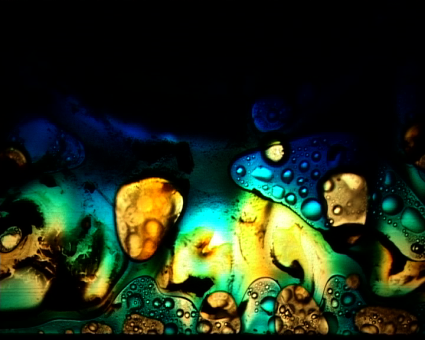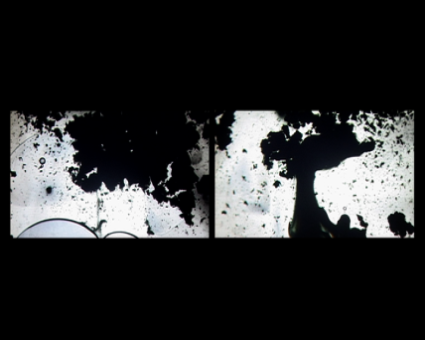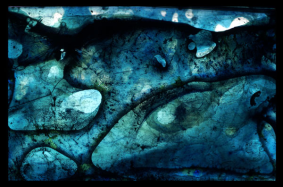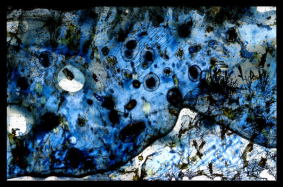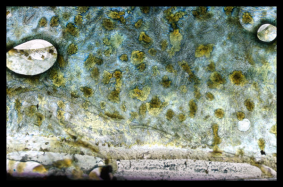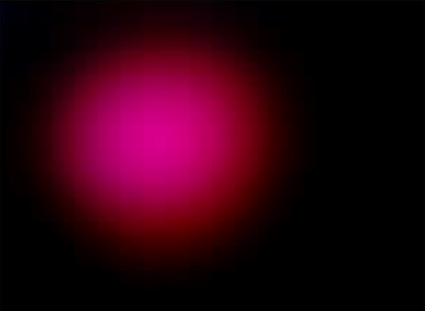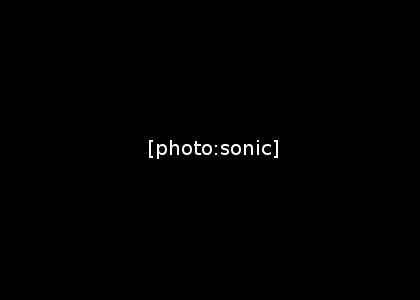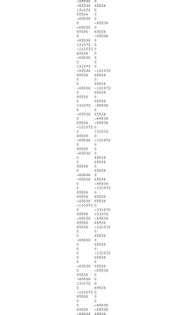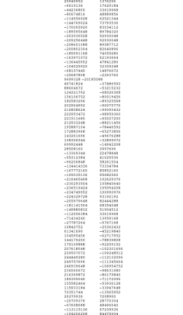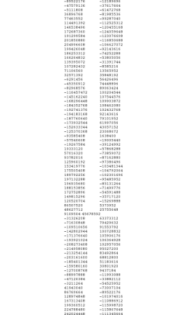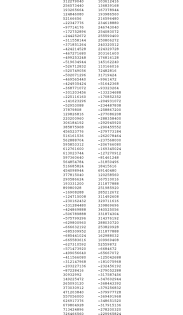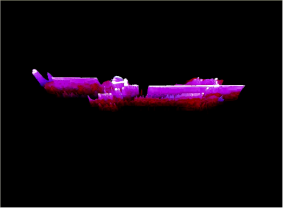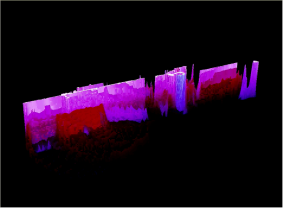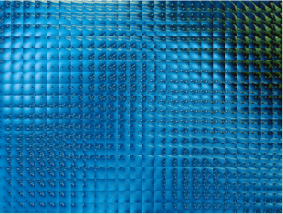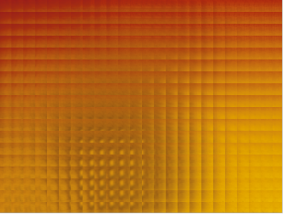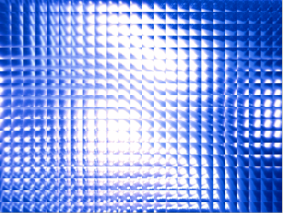Intertwingularity is not generally acknowledged, people keep pretending that they can make things deeply hierarchical, catergorizable and sequential when they can't. Everything is deeply intertwingled. Ted Nelson 1974

Photographic Practice as a Complex System
As with most complex systems that cannot be controlled in detail, the question is to find ways to manoeuvre or shepherd the spontaneous behaviour of a system, for example the materials the artist uses, towards some goal. The process of production of form needs to be half planned and half self-organized. The materials (whether hardware or software) must be allowed to have their say in the final form produced. Manuel De Landa
As a philosophy of practice, complexity gives voice to the connections, interactions, and indeterminacy, that accompany unconventional/experimental approaches to photography. It also acknowledges the non-linearity of making and thinking within visual arts practice in general. With regards to this research project, many of the experimental processes were undertaken concurrently, the outcomes of which would generate feedback - informing those processes; advancing further experimental processes; raising new questions; and guiding the text-based research. The interconnectedness of making and thinking are embodied in the artifacts including the wiki - which has developed alongside the studio research. It has evolved and changed and like the other artifacts is a reflection of the paths taken to arrive at this point in the research process.
Not only does complexity support the generation of artifacts, it forms the basis for the critique of those artifacts. The artifacts are the result of a systems approach to photography that sits within an ecology of post-photographic practice and can be critiqued as part of a photographic counter-practice and as playing against the photographic program.
Discretely, the artifacts are elements that critique particular aspects of photographic process, practice and technology. Some are the result of working with marginalized or obscure processes, playing against their intended function in order to critique our assumptions about what photography is and can be. Others are an engagement across technologies, exploring the integration of photography into digital media, and highlighting the processes that underlie these translations. Underpinning all of the works is an understanding that photography is a complex system that generates information surfaces. As a whole, the artifacts speak of photography's history, contemporary condition and possible futures. They are also articulations of the possibilities of photographic abstraction as inclusive systems of processes and practices that focus on connections, rather than medium specificity. Collectively these artifacts embody the transition of photographs from object to pure information.
Complexity allows us to contemplate different representations at the same time. The rabbit-duck illusion applies here. The artifacts are different representations simultaneously - linking at many levels. For example, artifacts can be clustered via process; by the way in which they play against the photographic program; by their levels of abstraction; by their surface/interface; by the way they fit in a post-photographic practice; and by the way they function as a system as a whole.
The Processes at Play
Explorations into photographic processes shift the emphasis from taking to making photography; from the photograph to photography; from what photography is to what photography can be; from the camera to the multiplicity of interactions with the materials and apparatuses of photography. These approaches also generate and highlight various abstractions of photography -from the aesthetic outcomes of direct engagements with photographic materials to the abstraction of photography as a means of representation and indexicality.
Many of the processes generated in the course of this research project have emerged from an understanding of the chemical, historical and technological characteristics of photographic processes. Accompanying each process, are conscious endeavours to play against their intended functions; to generate "informative" images/artifacts; and contribute (via perturbations) new information to the photographic universe.
Exposure and development play an integral role in the chemical processes of photography. They are typically understood as discreet steps in realizing a photograph. In the artifacts develop, emulsional and crysalis exposure and development are reconfigured and presented as the subject of photography. These artifacts have derived from a direct engagement with light-sensitive photographic materials - develop and emulsional are the result of experiments that focus on the fluidity of photographic chemical solutions; and crysalis is an emergent series of cameraless photographic images that stand as evidence of a process undertaken.
develop departs with the traditional techniques and practices of the photographic printmaking process of cyanotype. In develop cyanotype is removed from its traditional supports of paper or cloth and from its conventional context. As part of the process, cyanotype solution is suspended in custom made capsules and exposed to heat and light, in real-time. This experimental approach to photographic chemistry sets up a complex system which both depends on and contributes to its environment. Even though the same procedure is followed with each experiment (half-planned), the system generates diverse and indeterminate results (half self-organized). The chemistry has its say in the final form. It is photography that is contingent on complex chemical reactions and not the camera program.
In emulsional the subject of photography is the fluid, light-sensitive responses of silver salts. Informed by the experiments undertaken in develop, it also examines the usually discreet photographic processes of exposure and development. In this case, silver gelatin emulsion, suspended in its development solution, is displaced from its paper/film support. The process establishes a complex system with the same blend of planned procedure and self-organized outcomes. emulsional has undergone further processes re-presenting the experiments as spaces on screen; as chemical interfaces. The split screen articulates surface tension, organic movements and the balance between containment and freedom within these systems. The soundscape that resolves emulsional adds a further level of information. A written description of the process of its making is translated into an aural representation using voice generation software. Its abstraction into sound, highlights the levels of discreet information that accompany the translation of chemical photography into digital form.
crysalis is a series of informative images that are direct outcomes of the processes that generated develop. They are the emergent crystalline structures that result from the unconventional treatment of cyanotype solution. Despite the fact that the same procedure/conditions are implemented each time, the resulting images are diverse and unpredictable - they encapsulate the multiple possibilities/ trajectories that complex systems can take - small differences can generate extraordinary changes in outcomes. crysalis embodies the process; it is evidence of the process having taken place; articulates concepts of complexity; and challenges the conventions of how photographs can be made.
The processes that generate the images of photism are the result of an investigation of exposure via electro-photography. Kirlian photography or electro-photography uses high voltage electricity to generate responses onto film. A custom designed/built device extends this photographic process to create literal tracings of electricity conducting, charging and passing directly through film. The cameraless process occurs in complete darkness and the results are both unpredictable and invisible until the film is processed. Each resulting photograph is an event, not the documentation of an event. The photographic images that constitute the photism series are the result of an experimental mode for generating photographs not determined by the photographic program - they embody indeterminacy; provide the photographic universe with new information; and challenge photography's indexical relationship.
Abstracting and Translating Information Surfaces
Our contemporary experience of visual information is frequently mediated by a screen. The screen is the primary interface for electronic media; the pixel is the basic unit of composition of a screen image. The screen is a constantly changing field of visual information, quite different from the static nature of photographs.
The conscious play with the relationship between the emulsion that constitutes traditional black and white photographs and moving images that rely on a screen as their support is addressed in emulsional. dissolve is a moving image work that extends this form of inquiry further by exploring our engagement with the screen as a surface. It is a contemplation of image transmission and translation in which photographs from photism are the basis of the process. Transitions (cross dissolves) are used to link photographic images and generate movement between frames. The dissolves become sites of tension and release; of emergence and dissipation. This process is amplified by the compression (codec) and resolution of the work, which makes conscious the interplay of "little squares" that form the basis of electronic images on screen.
The mathematical computations - the algorithms that encode and decode our information, are hidden behind interfaces. There are degrees of separation that exist between our interactions and the operational logic of technological apparatuses. Embedded in the ambient soundtrack of dissolve is an encoded aural description of the process of its making. It is a soundscape designed for the contemplation of our contemporary visual experiences; and to highlight the levels of discrete, inaccessible information that accompany these visual encounters.
The translations of photography across media offers the potential for new representations of visual information. Accompanying the transitions are also new and different levels of abstraction; and an evolving range of possibilities and destinies for photography. As artifacts, photo:sonic, endcode, surface-space and photographic terrains explore different forms of abstraction, with photography as their foundation. They articulate the significance of photographs as information surfaces - the shift from object to data; from surface to interface. They are translations into new forms of photographic information; they are "informative" artifacts.
photo:sonic presents photography abstracted and translated into soundscapes. As part of this process, images from the photism series have been scanned using synthetic vision software; and the tonal and spatial information of each photograph interpolated into frequency. These transitions into sound are dependent on the information contained on the photographs' surface. Individual sound files generated for each image, are assembled to form the basis for the soundscapes. The process of scanning images and converting them into sound is known as visual prothesis. It enables people without vision to engage with the photograph and the moving image. photo:sonic shifts the significance of the photograph as object, by transposing its value to the information contained on the photograph's surface.
endcode is a further abstraction and translation of photography, this time it returns to paper support and takes the form of numerical print out. One photograph converted into sound is then encoded into a linear sequence where the values of frequency (tone and spatial information) are represented by numerical values. Image-sound-code. A visual, aural, and numerical representation of the same information. This artifact, presented in numerical order of 1865 pages, has the potential to be translated back to image. It highlights the numerical code that is at the basis for most of our contemporary visual information; and the computations that are an essential component in the digital translation of photographic information.
Software applications underpin a great deal of contemporary photography. Many of the artifacts of this thesis have been developed and resolved with the use of software programs. Of all the artifacts, photographic terrains and surface-space raise the relationship between photography and software applications to a conscious level of critique.
photographic terrains - are abstractions of photographs in space. Playing against the intended function of geographic information system software, the photographs from crysalis and photism are mapped via their surface information into three dimensions. This process involves plotting the information of each pixel within a photographic image - assigning it a value based on its tonal intensity. The resulting collection of values are then transposed onto x,y,z axes - the phase space portrait of the photograph's surface information. The resulting artifacts are digital topologies of photographic surfaces. The photographs are not just translated into digital form, completely new information is generated and employed; transforming two dimensions into three. It offers a new kind of photographic objectness.
surface-space focuses on the visual representations of the abstraction of photographs by algorithm. This process is made possible by an open source software application which differs from the "black-box" programming that Flusser warns against. Open source software emphasizes transparency and allows users to not only view the programming code but also use it and change it as they see fit. In this instance, the software application is employed to select images generated throughout the research project, at random. Each random selection is given the same treatment by an algorithm that is designed to zoom and move over the surface of the image; determining what and when it is viewed. At the same time the computer-generated magnification screen of overlapping lenses obscures the image. In this way, surface-space is a conscious articulation of the digital processes photography engages with and the supports (screen) that accompanies digital visualization. The process that generates this artifact is half-planned and half self-organized - the images are determined; and yet how they appear, when they appear, and in what sequence are not possible to predict. Randomness is a parameter of the program and process. It is a post-photographic, post-optical process which has no point of view but rather a visual context determined by the interactions between photographic images and numerical code.
glowing emissions is a different kind of abstraction all together - it is not derived from a photograph but from an apparatus that has an increasing presence in generating photographic information. The small, peripheral light of a computer is transformed into a dominant presence on screen. The persistent flashing of the LED, is amplified by the soundtrack and continual replay of the same hypnotic scene. glowing emissions is a luminous reminder of the technology that underpins our contemporary experiences. It is a meditation on the role of the apparatus; and the relationship between technology and visual information. It identifies a new apparatus to play against. There are two kinds of light - the glow that illumes, and the glare that obscures.  Thurber
Thurber
Wiki as exegesis - network - artifact
The wiki exists as different representations at the same time. It supports the ideas and artifacts of this thesis through its content and by its nature. The wiki has functioned as a hub of the research project - facilitating and generating a multitude of links between studio and text based research. As an exegesis it embodies the interactions and connections that have formed throughout the research process. The wiki is a portal to the essays that provide the basis and context for the thesis; it supports archives of artists, authors, literature, and websites that relate to the research project; it contains a catalogue of the artifacts of this thesis; and it is an online resource - with links to other websites and the potential for generating a community - nested within the complex network of the world wide web.
As a hypertext based medium and artifact - with a non-linear navigation structure and a large number of links between pages - the wiki is an articulation of the principles of complexity addressed in the thesis. The wiki offers a direct engagement with concepts of connectedness, holism, non-linearity, links, clusters, networks, and systems thinking. An engagement with the website, is an engagement with the connections and pathways explored throughout this research project. As in the case with complex systems, there are always possibilities that paths are followed and connections made, that were not directly pursued in the course of the research. This is true of all the artifacts and the essays of this research project. The unexpected and unintentional connections are a welcomed addition, viewed as emergence, they further contribute to the overall philosophy of this thesis.
[photo:fugue] - complexity in the photographic universe
This research project forms part of a photographic practice that continually searches for new modes of making and thinking about photography. The artifacts are elements in this expanding and evolving system/practice that explores, critiques and evaluates the complexity of the photographic universe. The information, ideas and patterns that emerge between, across and through these artifacts speak of photography's history, contemporary condition and possible futures. Individually, they engage with particular aspects of the research project. Collectively, the artifacts articulate the complex and evolving relationships, interdependencies, and possibilities of photography. In this way, they embody principles of complexity - indeterminacy; non-linearity; connectedness; and the whole.
Complexity offers a more appropriate account of this research process and resulting artifacts, than can be offered by conventional critiques. The essays and artifacts demonstrate how complexity resonates within a visual arts context generally, and experimental photographic practices in particular. They also show how complexity can articulate photography's contemporary condition and possible futures. Complexity is inclusive of conventional critiques and theories of photography. Furthermore it offers the potential to expand critiques and theories - making room for new kinds of conversations; and new kinds of photography. Complexity offers a range of principles and concepts that better account for photography's transitions within visual and information cultures.
Complexity offers a transdisciplinary approach to photography, in which conventional boundaries of media are replaced by the weaving of connections, interactions and links across media generating complex processes, patterns and meaning. The artifacts and essays of this research project embody this transdisplinary interconnectedness - they are interdependent and intertwined. They are articulations of photography in real-time.
Throughout this research project, complexity has been established as part of photography's present. Understanding complexity now, provides a context for understanding photography's potential and future possibilities. The futures of photography and complexity are deeply intertwingled.

Go to The Research Project |Go to StudioResearch | Go to TheArchive | Go to ArtistArchive | Go to LiteratureArchive | Go to AuthorArchive | Go to Glossary of Terms | Go to photo:fugue| Go to Why use Wiki? | Go to HomePage
